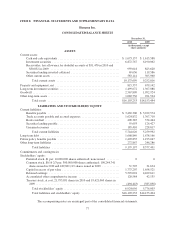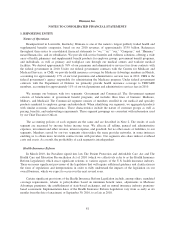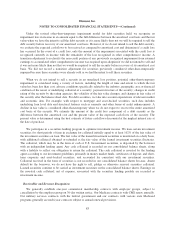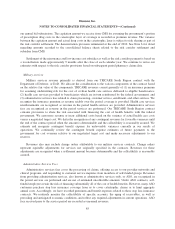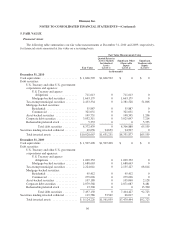Humana 2010 Annual Report Download - page 96
Download and view the complete annual report
Please find page 96 of the 2010 Humana annual report below. You can navigate through the pages in the report by either clicking on the pages listed below, or by using the keyword search tool below to find specific information within the annual report.Humana Inc.
NOTES TO CONSOLIDATED FINANCIAL STATEMENTS—(Continued)
Other Revenue
Other revenues primarily consist of copay revenues associated with our mail order pharmacy as well as
patient services revenue associated with the December 21, 2010 acquisition of Concentra Inc. more fully
described in Note 3.
Revenues associated with RightSourceRxSM, our mail-order pharmacy, are recognized in connection with
the shipment of the prescriptions.
Patient services include workers’ compensation injury care and related services as well as other healthcare
services related to employer needs or statutory requirements. Patient services revenues are recognized in the
period services are provided to the customer when the sales price is fixed or determinable, and are net of
estimated uncollectible accounts and contractual allowances.
Receivables
Receivables, including premium receivables, patient services revenue receivables, and ASO fee receivables,
are shown net of allowances for estimated uncollectible accounts, retroactive membership adjustments, and
contractual allowances.
Policy Acquisition Costs
Policy acquisition costs are those costs that vary with and primarily are related to the acquisition of new and
renewal business. Such costs include commissions, costs of policy issuance and underwriting, and other costs we
incur to acquire new business or renew existing business. We expense policy acquisition costs related to our
employer-group prepaid health services policies as incurred. These short-duration employer-group prepaid health
services policies typically have a one-year term and may be cancelled upon 30 days notice by the employer
group.
Life insurance, annuities, health and other supplemental policies sold to individuals are accounted for as
long-duration insurance products because they are expected to remain in force for an extended period beyond one
year due to contractual and regulatory requirements.As a result, we defer policy acquisition costs and amortize
them over the estimated life of the policies in proportion to premiums earned. Deferred acquisition costs are
reviewed to determine if they are recoverable from future income. See Note 18.
Long-Lived Assets
Property and equipment is recorded at cost. Gains and losses on sales or disposals of property and
equipment are included in administrative expense. Certain costs related to the development or purchase of
internal-use software are capitalized. Depreciation is computed using the straight-line method over estimated
useful lives ranging from 3 to 10 years for equipment, 3 to 7 years for computer software, and 20 to 40 years for
buildings. Improvements to leased facilities are depreciated over the shorter of the remaining lease term or the
anticipated life of the improvement.
We periodically review long-lived assets, including property and equipment and other intangible assets, for
impairment whenever adverse events or changes in circumstances indicate the carrying value of the asset may not
be recoverable. Losses are recognized for a long-lived asset to be held and used in our operations when the
undiscounted future cash flows expected to result from the use of the asset are less than its carrying value. We
86



